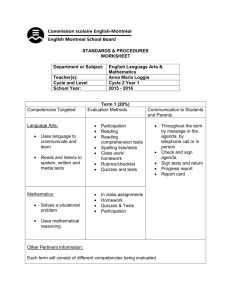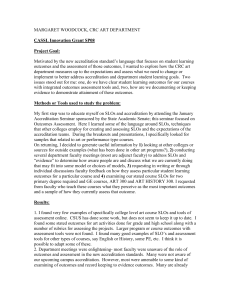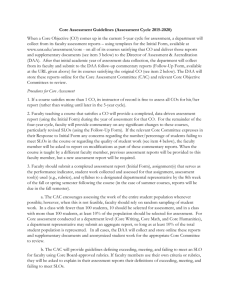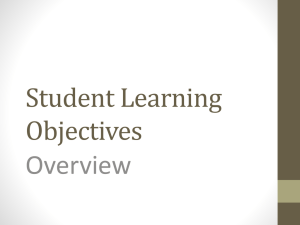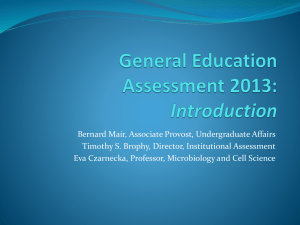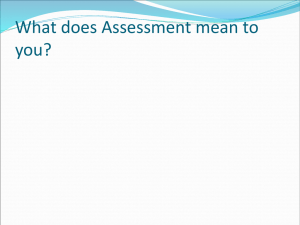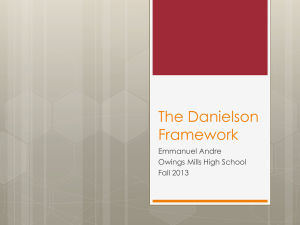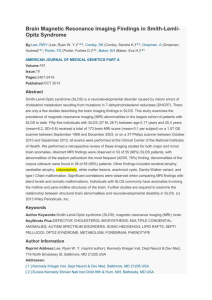Direct_Assessment
advertisement
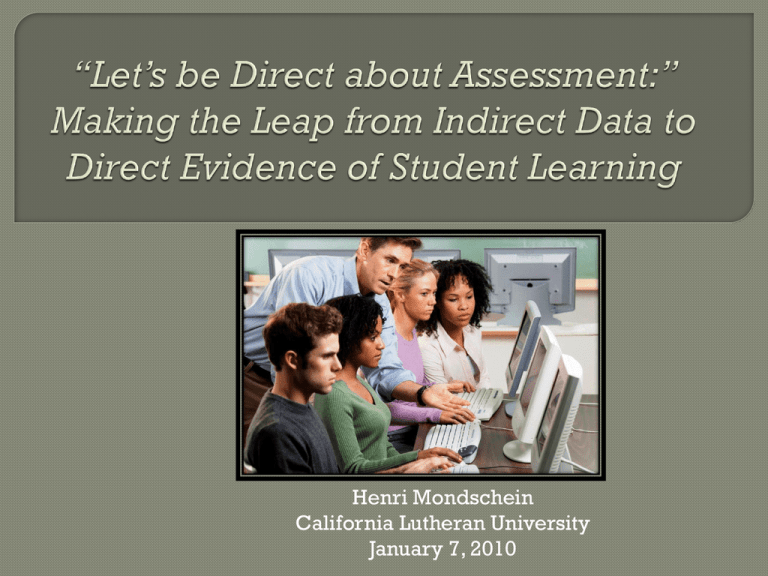
Henri Mondschein California Lutheran University January 7, 2010 Explain the difference between indirect and direct assessment Construct a curriculum map Apply ACRL standards & learning outcomes Create a “quick write” exercise to assess learning “The systematic collection of data and information across courses, programs and the institution, as an integral part of teaching and learning used to help both, and an essential component of a college’s mission.” Morante, 2003 Student Perceptions of learning Self-assessments Focus groups Graduation rates Products of Student Learning Portfolios Signature assignments Capstone projects Outcomes • What do you want students to do? Curriculum Pedagogy Assessment Criteria Adapted from Kenney (2008) • What do the student s need to know? • What is the learning activity? • How will the students demonstrate the learning? • How will I know how the students performed? • Find three scholarly articles on topic • How to use Academic Search Premier • Short intro to database • Teams researching topics • Team debriefings • Presentations • Worksheet • Citations •Quick writes • Scoring rubric Program Reviews Department chairs Subject liaisons Curriculum Maps/Collection Development Integrate IL into courses Library resources Assessment Quick writes/quizzes SLO data for Educational Effectiveness Department Student learning outcomes (SLOs)/Competencies Curriculum maps Assessment instruments Scoring rubrics Courses Competen cies • Identify key courses for integrating information literacy • Determine IL competencies for each course • Align ACRL standards/campus SLOs with competencies SLOs Instruction Assess ment • Review syllabi & course assignments • Create lesson plans • Create quick writes, quizzes, exercises & scoring rubrics Problemsolving exercise 10 minutes Scoring rubric Quick Write ACRL standards SLOs BB Skylight Survey Monkey Rubistar: www. http://rubistar.4teachers.org/ Interactive Psychology Quick Write Quiz/Exercise : http://tinyurl.com/28ugcpa 2 3 1 3 4 4 1 International students Quarterly series 1 unit workshops American Classroom Research & Writing Critical & Creative Thinking UNIQUE ISSUES Language barriers Learning styles Plagiarism Anxiety Time SOLUTIONS Identify clear learning outcomes Enunciate carefully Give precise instructions Use emphasis in instructions Give examples of plagiarism Allow extra time for quizzes, in-class exercises Provide opportunities for collaboration Appointments/office hours Quick writes & quizzes are snapshots Assess students over time Create quiz items bank Embed quiz items in course exams Don’t try to assess every session Avery, E. F. (2003). Assessing student learning outcomes for information literacy instruction in academic institutions. Chicago: Association of College and Research Libraries. Grassian, E. S., & Kaplowitz, J. R. (2009). Information literacy instruction: Theory and practice. New York: Neal-Schuman Publishers. Hernon, P., & Dugan, R. E. (2002). Outcomes assessment in your library. Chicago: American Library Association. Kenney, B. (2008). Revitalizing the one-shot instruction session using problem-based learning. Reference & User Services Quarterly, 47(4), 386-91. Retrieved from Library Lit & Inf Full Text database. Morante, E. A., & College of the Desert, P. A. (2003). A handbook on outcomes assessment for two year colleges. Retrieved from EBSCOhost. Stevens, D. D., & Levi, A. (2005). Introduction to rubrics: An assessment tool to save grading time, convey effective feedback, and promote student learning. Sterling, Va: Stylus Pub.
